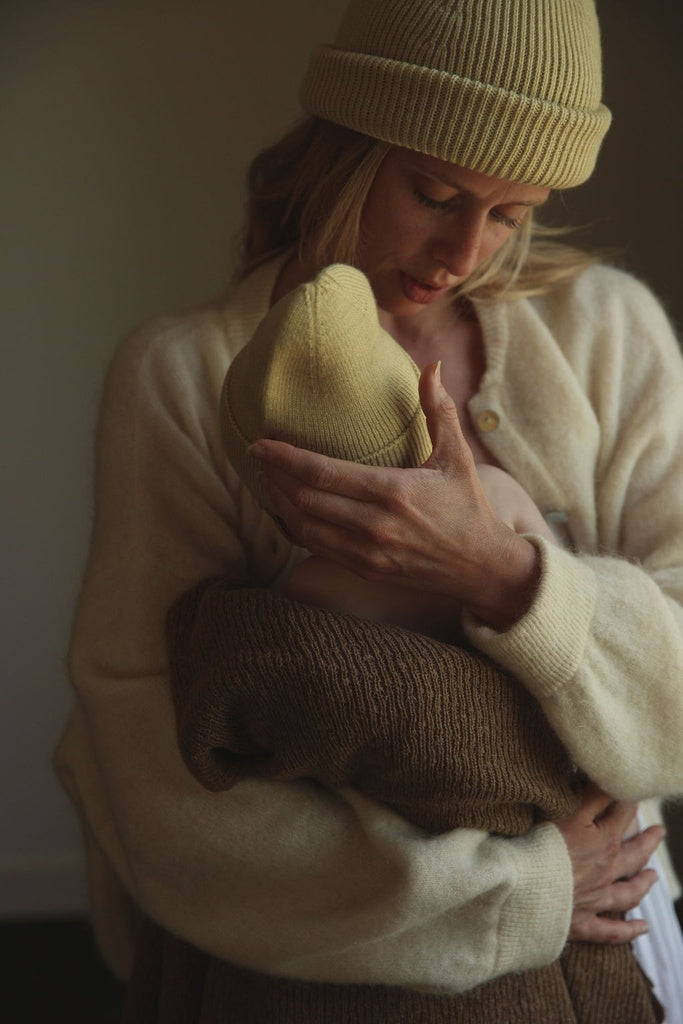
🌿 Natural Baby Shower Checklist – Your Warm and Sustainable Start
Share
A little one is on the way... and you'd love a gentle, peaceful start. No unnecessary clutter, but with the most beautiful basics that actually make a difference. At Atelier de Wevershoek, we totally get that: less plastic and fuss, more softness, and pure materials that truly feel good.
🌸 Tip: Don't forget yourself in all the preparations! We've also created a natural maternity checklist for moms , with soft basics for your comfort.
That's why we've created this practical checklist full of sustainable basics. Everything you (and your baby) really need – no more, no less.
In this blog:
- 👶 Baby's first clothes
- 🛁 Changing & bathing
- 😴 Sleep like a baby
- ♻️ Washable diapers
- 🤱 Breastfeeding essentials
- 🍼 Bottle feeding
- ✨ My own experience (lotus birth & co-sleeping)
- 🌸 Finally – golden tips
👶 Baby's first clothes
A newborn's skin is still so delicate. That's why we only use the softest fabrics next to the skin. Think organic cotton or – even better – wool and silk.
Why wool/silk?
Wool warms, silk cools. Together, they help your baby regulate their temperature without expending energy. Energy that can then be channeled into growth and development.
Wool breathes, is self-cleaning, and rarely needs washing (a quick airing out is fresh). Silky smooth against your skin, convenient for you.
Starter basics (size 50/56):
✔️ 3 wool/silk (wrap) rompers with long sleeves
✔️ 2 soft rompers
✔️ 3 sweaters or shirts with long sleeves
✔️ 2 vests
✔️ 2 pairs of pants/leggings
✔️ 2 bow hats (must-have!)
✔️ 1 jacket or wool fleece vest
✔️ 2 pairs of wool socks or slippers
💡 Tip: Wool blends well with cotton. So any cotton bundles you might already have can still be used.
🛁 Changing & bathing
Natural care = warmth + comfort. No cold wipes or irritating lotions, but softness and simplicity.
Handy basics:
✔️ Changing pad with natural cover
✔️ Heat lamp above the dresser (worth its weight in gold in winter!)
✔️ Baby bath (although the first bath can wait a while)
✔️ Soak organic cotton pads in lukewarm water
✔️ 5 hydrophilic cloths for gentle drying
✔️ Baby oil or shea butter for care
✔️ Soft hair brush
✔️ Healing wool for the navel
😴 Sleep like a baby
Sleep is key – for your baby and for you. Create a cozy, safe environment with natural materials.
Sleep checklist:
✔️ Co-sleeper or crib
✔️ Silk or cotton crib canopy
✔️ Natural mattress (e.g. coconut fiber)
✔️ 2 fitted sheets + 2 flat sheets + 2 moltons
✔️ Wool blanket (airy in summer, warm in winter)
✔️ Sheepskin (optional, for extra security)
✔️ 2 hot water bottles (especially for cold rooms)
✔️ Natural rubber pacifiers (if desired)
💛 Make sure you have a sleeping environment that is not too warm and not too cold – wool helps tremendously with this.
♻️ Washable diapers
More and more parents are switching and swear by it: less waste, less chemicals, more softness.
What you need:
✔️ ±20 cotton diapers
✔️ 3 woolen overpants
✔️ Organic inserts
✔️ Healing wool for red bottoms
✔️ Lanolin to treat wool
✔️ Wool detergent & ox gall soap
✔️ Diaper pail + 2 laundry bags
💛 We ultimately chose the sustainable disposable diapers from Eco by Naty combined with the washable wipes from Cheeky Wipes.
🤱 Breastfeeding essentials
Feeding is primarily about you and your baby. But a few things make it just a little more relaxing.
✔️ 2 nursing bras without underwire, preferably made of natural material
✔️ 3–5 pairs of washable nursing pads (wool/silk or cotton) to absorb leakage
✔️ Nursing pillow for support of your arms and back
✔️ Shea butter or healing wool for sensitive nipples
✔️ Nutritious diet + supplements – eat a varied and nutrient-rich diet, and supplement with supplements such as liquid omega-3 for extra support if needed
💡 Tip: Make a "feeding basket" with compresses, treats, water, and your phone or book – everything to keep close at hand during feedings.
🍼 Bottle feeding
Choose safe and natural here too:
✔️ 2 glass baby bottles or BPA-free bottles
✔️ Natural rubber teats
✔️ Bottle brush
✔️ Organic infant formula or breast pump
👉 Always sterilize bottles and teats before use.
✨ My own experience with the second baby
With my second daughter, I opted for a full lotus birth —where the baby decides when the placenta detaches. That felt like the most natural and peaceful start I could give her.
That first week, she wore no clothes, just two woolen blankets , a little bonnet, and socks. No stimuli, no fuss, just warmth and security. We slept together in bed, close together—an experience I found incredibly valuable.
💡 Important: Co-sleeping can be wonderful, but it does require safety. Always seek expert advice on how to do this safely if you're considering it.
All of this made me realize even more clearly: a baby actually needs so little in the beginning. With just a few soft basics, you can create all the peace and security that matters. 🌸
✨ Finally – our golden tips
- Choose natural materials : wool, silk and organic cotton are the best for your baby.
- Less is more : a few good basics last longer and feel better than a closet full of stuff.
- Warmth is everything : layers, blankets, skin-to-skin – your baby feels so safe.
- Ask for help : from your maternity nurse, your community, or simply via our DMs.
💛 This checklist has been lovingly compiled by Atelier de Wevershoek, so you can focus on what really matters: enjoying your little one in peace and security.
🌸 And remember: you deserve to be pampered too. Also check out our maternity supplies for mom – everything you need to start your pregnancy warm, comfortable, and relaxed.
